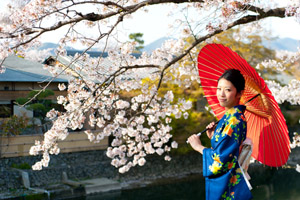Japanese Geishas

In the early 11th century, two women of noble birth created a new dance to entertain the warrior's circles. They dressed in white costumes representing the court dress of the warriors. They wore a tall white hat, long white gown, and a sword at the waist. This form of dance caught on and spread. Over time the costume changed to a black hat and red skirt. Then both the hat and sword disappeared. Many believe that the women who preformed this dance and wore these costumes were the early predecessors of geisha.
During the 18th century, many theaters provided entertainment for the townspeople. Many teahouses were located around the theater entrances. The teahouses were not just for tea; tickets for shows would be sold there, food and drink was served, and meetings with courtesans were arranged. The actors and theater-goers that came to the teahouse could enliven their parties by calling on the services of independent performers: singers, dancers, samisen-players, and jesters. These performers were called geisha. The word geisha is made of two characters, one meaning art and one person.
In 1779, authorities in Tokyo were upset by activities of the geisha. One thing that bothered them was the fact they didn't pay taxes on their wages. A meeting was held and a registry office was created to control their activities. Disciplinary rules and regulations were formulated and a code of professional conduct created. The registry office issued strict orders about dress. Only plain configured materials were allowed. Hair was to be in a uniform style decorated with a single comb, and two pins, one large and one small. The office even encouraged recruitment of comparatively plain women. Artistic skills and talent were the basis on which women were to be considered.
Described as a "century old professional entertainer" the geisha is an important part of traditional Japanese social life. Usually circulating their services in the higher classes exclusively, these woman are extensively trained in many of the traditional Japanese arts. Her grace is exceptional, her charm, exquisite. These woman are professional hostesses in an exotic variation.
The earliest geishas were men, but by the 18th century women dominated the trade. Young girls may start training before reaching puberty. At age 17 they begin living in a maiko house young novice geishas called learn the arts needful to their trade. Only women who are at the top of their group and pass a rigorous exam actually become geisha.
Literary translated, geisha means "Beauty Person" or "Person who lives by the arts", and that they do. Geisha are masters in the arts; trained in music, calligraphy, Sado (tea ceremony) poetry, conversation and social graces as well as a three stringed instrument called a Shamisen. They dress in traditional kimonos, gorgeous in their elegance. Simple wooden geta clogs are worn for footwear, and hair is up in coiffures adorned with metallic accessories. The makeup of centuries is a white foundation, lips are painted a stark red. For the younger girl, only the upper lip is painted. For extra sensual appeal, a red streak is painted at the nape of the neck, for the more neck you show, the more risque your costume.
Within Tea Houses, the geisha organize themselves hierarchically with relationships based on the family model (i.e. mother/daughter younger/older sisters). Within each tea house is a "mother" who is in charge of the conduct and class of all her geishas contained therein. Also, each geisha has a senior elder sister who helps in her continuous training. In this way the traditional knowledge can be carried on.
Once the geisha were the trend setters of fashion and taste, now with Japan's modernizing their role has been less prevalent. During the 1940s, geisha entertainment was outlawed and many were forced into factory and industry labor. The late 1970s saw geisha numbers drop to around 17,000. Today they number fewer than a thousand found mostly in Osaka and Kyoto. Many Japanese businessmen find the company of modern hostesses and barmaids much more comfortable. While those who would appreciate fully the artistry of her talents are long gone, her honor to uphold the customs will remain as long as there are Geisha to serve and learn these ancient arts.